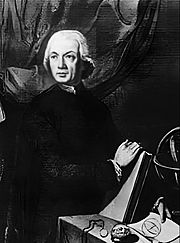Paolo Frisi facts for kids
Quick facts for kids
Paolo Frisi
|
|
|---|---|

Paolo Frisi by Andrea Appiani
|
|
| Born | 13 April 1728 Melegnano, Italy
|
| Died | 22 November 1784 (aged 56) Milan, Italy
|
| Nationality | Italian |
| Scientific career | |
| Fields | Astronomy |
Paolo Frisi (born April 13, 1728 – died November 22, 1784) was an important Italian mathematician and astronomer. He was known for his work in science and for helping to bring new ideas to Italy, like lightning conductors.
Contents
Paolo Frisi's Early Life and Education
Paolo Frisi was born in Melegnano, Italy, in 1728. He had a younger brother, Antonio Francesco, who later became a historian. Paolo went to school at a local Barnabite monastery, which is a type of religious community. He continued his studies at another Barnabite monastery in Padua.
When he was just 21 years old, Paolo wrote an important paper about the shape of the Earth. This paper helped him become well-known. Because of his growing reputation, the King of Sardinia offered him a job as a professor of philosophy at the College of Casale.
Challenges and New Opportunities
Paolo Frisi became friends with Alberto Radicati, who had very modern ideas for the time. Because of this friendship, Paolo's religious superiors moved him to Novara. There, he had to work as a preacher.
However, his scientific career continued to grow. In 1753, he was chosen as a member of the Paris Academy of Sciences. Soon after, he became a professor of philosophy at the Barnabite College of St Alexander in Milan.
Around this time, a young Jesuit criticized Paolo's paper on the shape of the Earth. This led Paolo to become friends with other thinkers who were also against the Jesuits, including famous people like Jean d'Alembert.
Teaching and International Recognition
In 1756, Leopold, the Grand Duke of Tuscany, appointed Paolo as a professor of mathematics at the university of Pisa. He taught there for eight years.
Paolo Frisi gained recognition from many scientific groups around the world:
- In 1756, he joined the Imperial Academy of St Petersburg.
- He also became a foreign member of the Royal Society of London.
- In 1758, he joined the Academy of Berlin.
- Later, he became a member of the Academies of Stockholm (1766), Copenhagen (1770), and Bern (1770).
Many rulers in Europe also honored him. The empress Maria Theresa even gave him a yearly payment of 100 sequins, which was a lot of money back then!
Later Career and Contributions
In 1764, Paolo Frisi became a professor of mathematics at the palatine schools in Milan. He also received special permission from Pope Pius VI to become a secular priest, meaning he was no longer under direct church control.
He traveled a lot, visiting France and England in 1766, and Vienna in 1768. Paolo was an expert in hydraulics, which is the science of how water moves. Because of this, people often asked for his advice on managing canals and other waterways across Europe.
One of his most important contributions was bringing lightning conductors to Italy. These devices help protect buildings from lightning strikes.
In 1766, Frisi was also elected a foreign member of the Royal Swedish Academy of Sciences.
Paolo Frisi passed away in Milan in 1784. Today, there is a street named after him in his hometown of Melegnano and a high school in Monza, honoring his memory.
Paolo Frisi's Works
Paolo Frisi wrote several important books and papers during his lifetime:
- Algebra e geometrica analitica (1782) - This book was about algebra and analytical geometry.
- Meccanica (1783) - This work focused on mechanics, the study of motion and forces.
- Saggio della morale filosofica - This was an essay on philosophical morals.
- Elogio di Galileo Galilei e di Bonaventura Cavalieri - This book praised the famous scientists Galileo Galilei and Bonaventura Cavalieri.
See also
 In Spanish: Paolo Frisi para niños
In Spanish: Paolo Frisi para niños
- List of Roman Catholic scientist-clerics
Images for kids
-
A 19th century medallion of Paolo Frisi on the facade of Palazzo Beccaria in via Brera street, Milan (birthplace of Cesare Beccaria).


